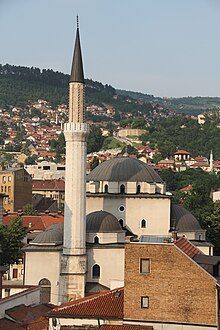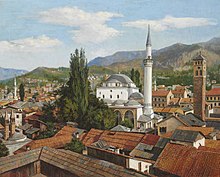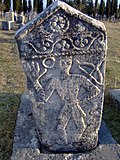Gazi Husrev-beg Mosque
| Gazi Husrev-beg Mosque | |
|---|---|
 Gazi Husrev-beg Mosque fromHotel Europe | |
| Religion | |
| Affiliation | Sunni Islam |
| Location | |
| Location | Sarajevo,Bosnia and Herzegovina |
| Geographic coordinates | 43°51′33″N18°25′44.5″E/ 43.85917°N 18.429028°E |
| Architecture | |
| Architect(s) | Acem Esir Ali "Alaüddin" |
| Type | Mosque |
| Style | Ottoman architecture |
| Completed | 1531 |
| Specifications | |
| Capacity | ~1,500 (including ~500 in courtyard) |
| Dome(s) | 9 |
| Dome height (outer) | 26 m |
| Dome dia. (outer) | 13 m |
| Minaret(s) | 1 |
| Minaret height | 47 m |
Gazi Husrev-beg Mosque(Bosnian:Gazi Husrev-begova džamija,Turkish:Gazi Hüsrev Bey Camii) is amosquein the city ofSarajevo,Bosnia and Herzegovina.Built in the 16th century, it is the largest historical mosque in Bosnia and Herzegovina and one of the most representativeOttoman structuresin the Balkans. Having been Sarajevo's central mosque since the days of its construction, today it also serves as the main congregational mosque of theMuslims in Bosnia and Herzegovina.It is located in theBaščaršija neighborhoodin theStari Gradmunicipality and, being one of the main architectural monuments in the town, is regularly visited by tourists.
History
[edit]
TheGazi Husrev-begMosque was built in 1530 as the central object of theBeg'sendowment,which also included amaktaband amadrasa(Islamic primary and secondary schools), a bezistan (vaulted marketplace), ahammam(public bathplace) etc. The foundation of this waqf by the contemporaryOttomangovernor ofBosniahad a crucial point in the development of the town. The architect's name is unknown, but after some speculations, which even included famousMimar Sinanas an option, most scholars agreed that Acem Esir Ali "Alaüddin", an Ottoman mimar ofPersianancestry, is the most probable builder. It is still possible that Sinan himself did inspect the work on the spot, since he was in the region at the time.[1]Historical documents testify thatRagusanmasons, requested from their government by Gazi Husrev-beg, participated in the building process.
Gazi Husrev-bey Mosque was the first mosque in the world to receive electricity and electric illumination in 1898 during the period of Austro-Hungarian Empire.[2]
Architecture
[edit]
The mosque belongs to the type of complex-spaced, multi-domed mosques and it is a represent of the Early Period ofClassical Ottoman Architecture(sometimes referred to as Early Istanbul Style). The central rectangular space, framed by high walls and covered with adomeresting onpendentives,represents the spine of the structure, while lower extensions lean to it and expand the volume of the interior space. Theqiblaside of the mosque is extended with a rectangular space which is covered by a semi-dome resting on two highly developedmuqarnasstructures. They stand in function of pendentives, reducing the rectangular outline of the ground level to the near semi-circle shape in level of the semi-dome. This area houses central architectural elements with religious purposes:mihrab,minbarand kursi and, being open to the central space with a huge arch, represents the focal point of the mosque. Two smaller spaces, called tetime[check spelling](sg. tetima) are located on the left and right sides of the central space, placed furthest from the Kibla side. They are covered by two lower domes resting on pendentives.
The exterior is dominated by the main dome, topped out only by a simple, yet monumentalminaret.The entry side is marked with aporticoresting on four wide columns and covered with little domes, only the central one, above theportal,being a bit greater than others, and resting on muqarnas-adorned pendentives, in contrast to others which are laid on simple, plain-surfaced pendentives. The monumental portal is richly decorated with muqarnas, as well as columns' capitals.
In his legacy, he stated: "Good deeds drive away evil, and one of the most worthy of good deeds is the act of charity, and the most worthy act of charity is one which lasts forever. Of all charitable deeds, the most beautiful is one that continually renews itself."[3]
Destruction and reconstruction
[edit]
During theSiege of Sarajevo,Serbian forces purposely targeted many centers of the city's culture, such as museums, libraries, and mosques, and fired on them generally. As the largest and best known, the Beg's mosque was an obvious target.


Having suffered a significant amount of destruction, the reconstruction of the Mosque started with foreign - mainly Saudi - aid in 1996, right after the war. The old and faded layer ofAustro-Hungariandecoration was removed and, since remains of older, historical layers of decorative painting weren't found,[dubious–discuss]a completely new interior was designed and applied by Bosnian calligrapher Hazim Numanagić in 2001/2002. Austro-Hungarian decoration, performed mostly in pseudo-Moorish style, remains only on the portal of the Mosque today.
Gallery
[edit]-
Mosque in 1900
-
The main entranceportalwith anislamic archbefore entering, and intricately carvedmuqarnason the portal and on the domependentivesabove. There is also anablaqdesign around the main entrance as well.
-
East side of the mosque
-
View from the market
-
The fountain in thesahn(courtyard) of the mosque
-
Gazi Husrev-beg Mosque'sporticowith 5 elegantislamic arches
See also
[edit]- Timeline of Islamic history
- Islamic architecture
- Islamic art
- List of mosques
- List of mosques in Bosnia and Herzegovina
References
[edit]- ^"Nihad Čengić - Begova džamija kao djelo umjetnosti".Retrieved17 July2016.
- ^Izvor: Dnevni avaz, br. 4297, godina XII, nedjelja, 9.9.2007., Panorama, str. 14
- ^Visit Sarajevo."Gazi Husrev Bey's Mosque".Archived fromthe originalon 26 April 2010.Retrieved12 May2010.
External links
[edit]- Religious buildings and structures completed in 1531
- Mosques in Sarajevo
- Stari Grad, Sarajevo
- Ottoman mosques in Bosnia and Herzegovina
- 16th-century mosques
- Rebuilt buildings and structures in Bosnia and Herzegovina
- National Monuments of Bosnia and Herzegovina
- 1531 establishments in the Ottoman Empire
- Attacks on religious buildings and structures during the Bosnian War
- Tourist attractions in Sarajevo
- Medieval Bosnia and Herzegovina architecture
- Gazi Husrev-beg's endowment
- Baščaršija











